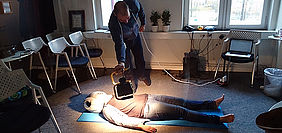The first 2014 Wireless Friday seminar in collaboration with EIT ICT Labs offers an inspiring presentation on designing for Somaesthetics by Professor Kristina Höök, KTH /SICS.
Venue: EIT ICT Labs Stockholm Co-location Centre, Isafjordsgatan 26, Kista
Date and time: Friday January 24 at 14.30
Abstract: In designing for bodily experiences, there has been a lack of theories that can provide the underpinnings we need to understand and deepen our design thinking. Despite all the work we have seen on designing for embodiment, the actual corporeal, pulsating, live, felt body has been notably absent from both theory and practical work.
At the same time, digital products have become an integral part of the fabric of everyday life, the pleasures (and pains) they give, their contribution to our social identity, or their general aesthetics are now core features of their design. We see more and more attempts to design explicitly for bodily experiences with digital technology, but it is a notably challenging design task.
With the advent of new technologies, such as biosensors worn on your body, interactive clothes, or wearable computers such as mobiles equipped with accelerometers, a whole space of possibilities for gesture-based, physical and body-based interaction is opened. How can we do a better job in interaction design involving our bodies? In this presentation Kia Höök will discuss how Shusterman’s theories of somaesthetics might provide some inspiration.
Biography:
Kristina Höök (b. 1964) is a professor in interaction design at KTH (The Royal Institute of Technology). Höök has published more than 100 journal papers, books and book chapters, and conference papers in highly renowned venues. A frequent keynote speaker, she is known for her work on social navigation, seamfulness, mobile services, affective interaction and lately, designing for bodily engagement in interaction through somaesthetics. Her competence lies mainly in interaction design and user studies helping to form design. Höök started and currently leads the Mobile Life centre that engages around 45 researchers.

